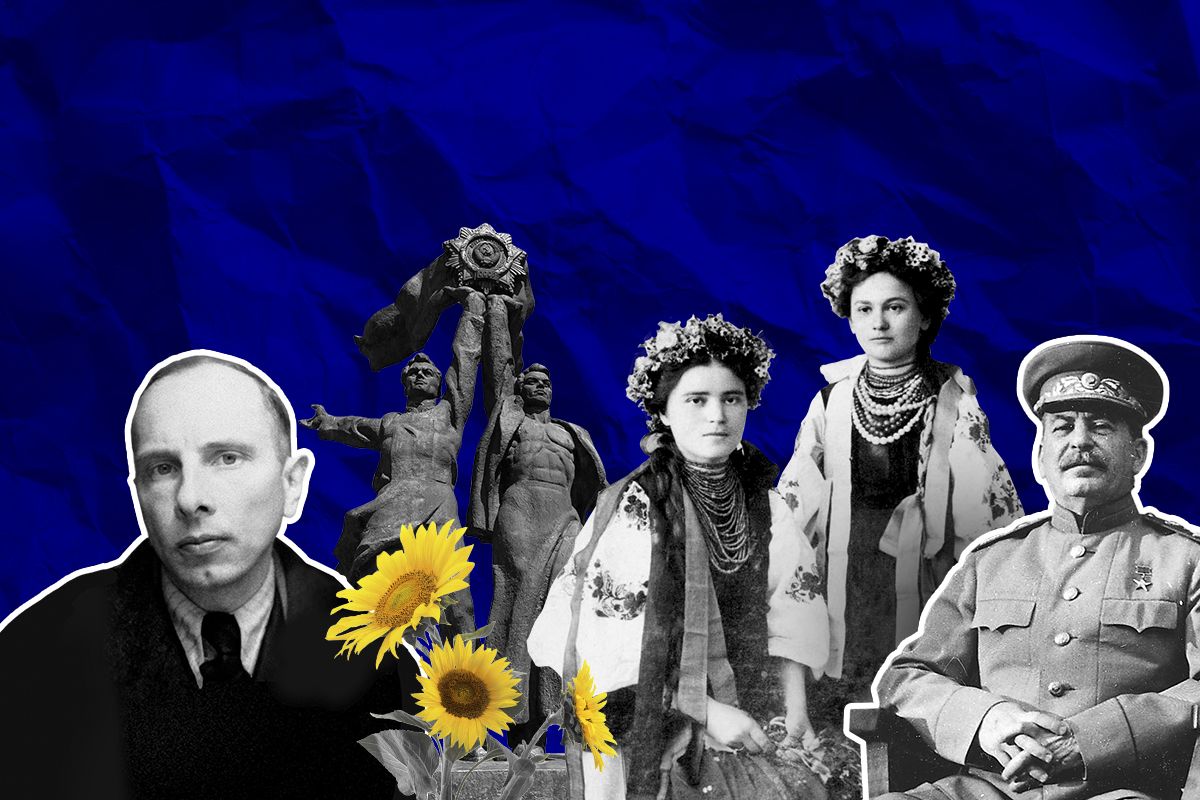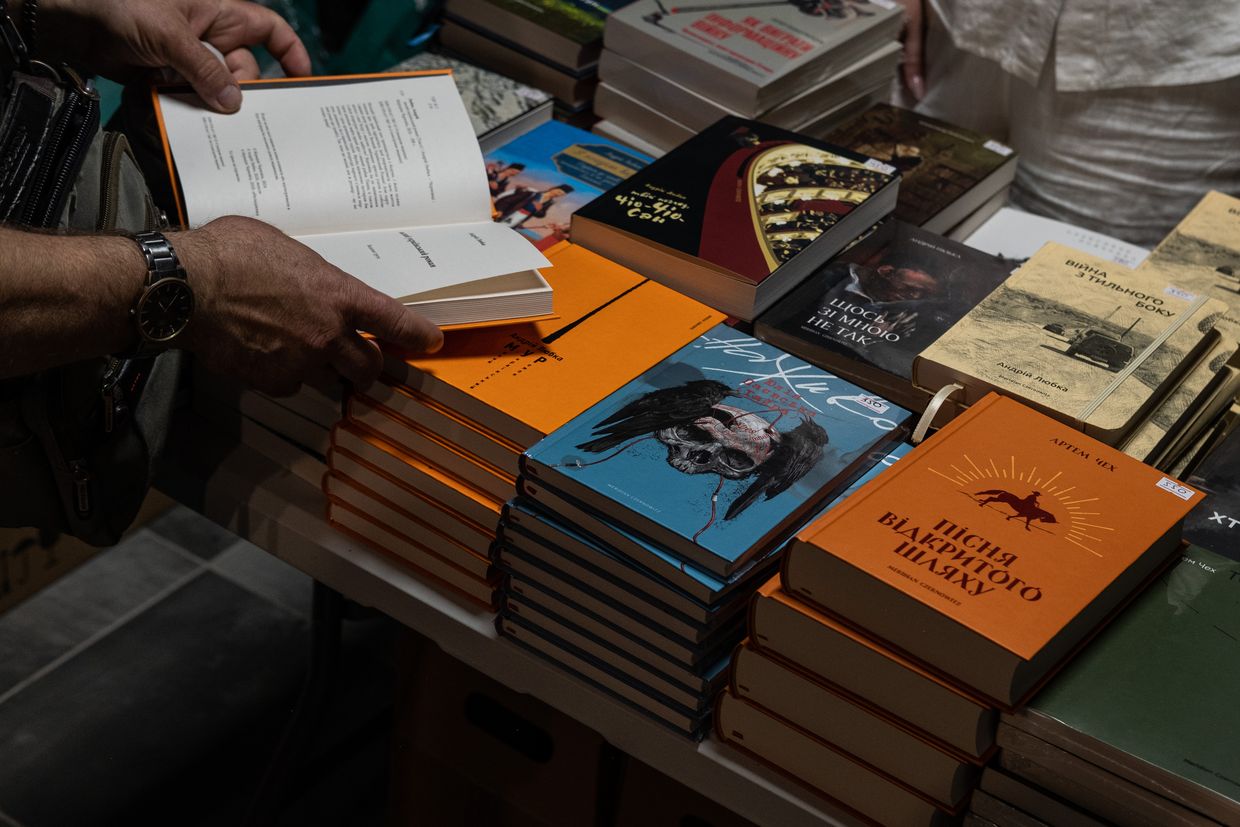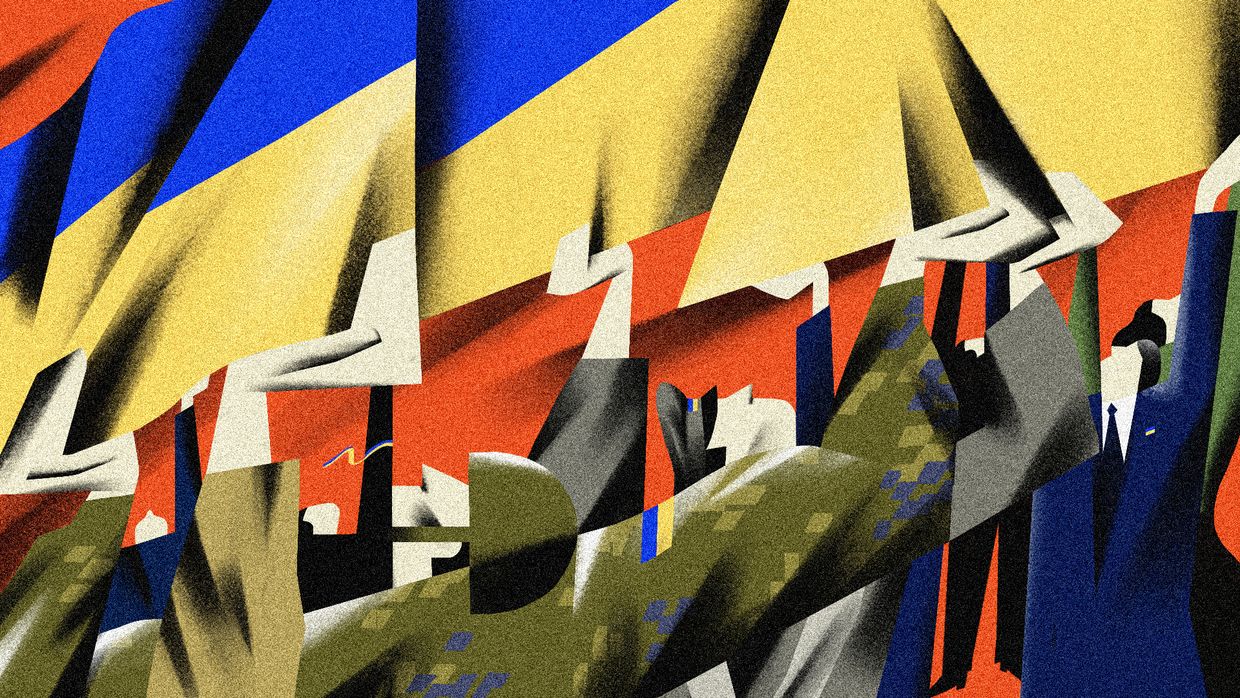
34 facts to learn about Ukraine this Independence Day
Photo taken from a drone on Aug. 20, 2023, shows the Motherland Monument in Kyiv, with the Ukrainian trident insignia being installed on a shield in the statue's left hand and the Ukrainian national flag seen on the right. The Soviet hammer and sickle symbol was removed in July for replacement, amid the Russian invasion of the country. (Photo by Kyodo News via Getty Images)
Ukraine is celebrating its 34th Independence Day on Aug. 24, 2025. To mark the occasion, we’ve asked the staff of the Kyiv Independent to share their favourite fact about Ukrainian history, culture, their hometown, or a famous Ukrainian — some of whom, you might be surprised to learn are from Ukraine. Read the list and see how many facts you already knew.
1. The geographic center of Europe is in Ukraine
A stone monument near the village of Dilove in Zakarpattia Oblast marks the spot officially recognized by Austro-Hungarian cartographers in 1887 as the geographical center of Europe. The geographical center of Ukraine is in Cherkasy Oblast, near the small town of Shpola (my hometown).
Yana Zhuryk, membership growth manager
2. Cossacks created one of the earliest constitutions
Zaporozhian Cossack statesman Pylyp Orlyk’s 1710 Constitution is considered one of the earliest constitutions in the world. It was one of the first in Europe to establish separation of powers and democratic principles, and predated the U.S. Constitution by decades.
Anna Yakutenko, video production manager
3. Ukraine is one of just four countries that has given up its nuclear arsenal
Ukraine is one of four countries that has ever given up its nuclear arsenal. At the time of the signing of the 1994 Budapest Memorandum, Ukraine’s nuclear arsenal was the third-largest in the world (after Russia and the U.S.). You can read more about Ukraine’s nuclear disarmament here.
Olena Yermakova, head of research at KI Insights
4. Underground Odesa
When people think about Odesa, the first associations are usually the sea and the architecture, not the massive catacombs beneath the city. Odesa’s catacombs are far bigger than the catacombs under Paris. By some estimates, they stretch up to 2,500 kilometers, compared to 300 kilometers in Paris. These tunnels were mostly abandoned after World War II. Today, they still attract tourists and adventurers — one of my weird childhood memories is actually a school excursion down there. You can explore Odesa catacombs in our travel video series.
Tim Zadorozhnyy, news editor

5. Kryvyi Rih is over 100 kilometers long
Kryvyi Rih is known for being the hometown of President Volodymyr Zelensky, but also for having a peculiar shape as Europe's longest city — it’s 126 kilometers (78) miles long.
Olena Yermakova, head of research at KI Insights
6. Kyiv is older than Moscow
The city of Kyiv was founded in the 5th century, while Moscow dates back to the early 12th century. Kyiv was the center of Kyivan Rus, one of the most developed states of medieval Europe.
Yana Zhuryk, membership growth manager
7. Donetsk was founded by a Welshman
The city of Donetsk was initially a settlement around a mine founded by a Welsh businessman named John Hughes. Many miners from South Wales went over to work in the mines, and the city was first called Hughesovka after Hughes.
Owain Jones, head of marketing
8. There’s a New York in Ukraine
There's a village of Niu-York (transliteration of Ukrainian spelling of New York) in Donetsk Oblast, now under Russian occupation. It was founded in the 19th century by German Mennonites, a Protestant religious community.
Kateryna Denisova, news editor
9. Ivano-Frankivsk’s unique town hall
The town hall in Ivano-Frankivsk is the only public building in Ukraine with a gilded top (an architectural feature mostly reserved for churches in Ukraine). It’s also the only town hall in Ukraine built in the Art Deco style.
Zakhar Protsiuk, chief operating officer
10. Ukraine’s oldest pharmacy
In Lviv, you can find an old pharmacy, founded in 1735. It’s the oldest working pharmacy in Ukraine, and even though it’s partially a museum, you can still buy medicine there.
Joseph Krochak, account manager
11. Kyiv’s heights
The tallest structure in Ukraine is the Kyiv TV tower, which is also the tallest free-standing lattice structure in the world. At 385 meters-high (1,263 ft), it is also one of Europe’s tallest structures. It was hit in a Russian attack in March 2022, but is still standing.
Dominic Culverwell, business reporter
12. And Kyiv’s depths
Kyiv’s Arsenalna metro station is the deepest metro station in Europe, located 105.5 meters (346 feet) below ground. Until 2022, it was also the deepest metro station in the world, but is now surpassed by a station in Chongqing, China.
Brooke Manning, senior community manager
13. The world’s longest apartment building
My hometown, the city of Lutsk, is home to the longest apartment building in the world. Built in the 1970s, its honeycomb design stretches for over 2.75 kilometers.
Yuliia Taradiuk, reporter
14. Ukraine has over 1,000 statues of one poet
There are 1,068 monuments of Taras Shevchenko, Ukraine’s national poet and hero, across the country. In total, there are 1,167 monuments of Shevchenko across the world.
Mykolaj Suchy, research analyst at KI Insights
15. Ukrainian minerals
Ternopil Oblast is where you can find the world’s longest gypsum cave, known as the Optimistic Cave. It’s Europe’s longest cave and is ranked among the top five longest caves globally.
Nadiia Pahava, communications manager
16. High jump
Ukrainian athlete Yaroslava Mahuchikh holds the world record for the high jump. Mahuchikh broke the record in July 2024 by clearing a 2.10-meter jump. The previous record had been held for over 35 years.
Oleksiy Sorokin, deputy chief editor
17. Sunflowers and soil
Ukraine is the largest producer of sunflower oil in the world, and vast sunflower fields are the country’s national symbol. Ukraine is also one of the most fertile places on earth, with over 25% of the world’s black soil (known as chernozem).
Yana Zhuryk, membership growth manager
18. Ukraine’s own Stonehenge
Near my hometown of Rozivka in Zaporizhzhia Oblast, there’s a fascinating archaeological site called the Stone Tomb. These ancient granite formations are covered with 4–5 thousand-year-old petroglyphs and are often called the “Steppe Stonehenge” for their mysterious and powerful presence. Today, this area is occupied by Russia.
Andrii Melnyk, junior product manager
19. Donetsk’s salt mines
The Salt Mines in Soledar, Donetsk Oblast, are currently under Russian occupation, but were unique for their long system of mines. It had a hotel, spa, and a huge 28-meter-high concert hall, where the Donbas Symphony Orchestra once performed. In 2019, a charity jazz festival took place underground in the mines for the first time, featuring jazz improvisations and an exhibition of works by Ukrainian artists.
Anastasiia Chernova, junior community manager
20. Kherson Oblast has a desert
Oleshky Sands in Kherson Oblast is among the largest deserts in Europe, located 25 kilometers east of the city of Kherson. It has been under Russian occupation since 2022. In the south of Kherson Oblast, there’s also Dzharylhach, a 42-kilometer-long sandbank, the largest uninhabited island in Ukraine.
Daria Kolos, digital marketing manager
21. The Battle of the Kalka River
The first significant Mongol military engagement in Europe took place in south-eastern Ukraine in 1223. The historic Battle of the Kalka River marked the first encounter between the Mongols and the coalition of Kyivan Rus princes. I used to swim in this river as a child, not realizing that it had witnessed a decisive battle centuries ago.
Andrii Melnyk, junior product manager
22. Ukraine has eight UNESCO sites
Ukraine is home to eight UNESCO sites: St. Sophia's Cathedral in Kyiv, Lviv's historic center, the Struve Geodetic Arc points, the Residence of the Bukovinian and Dalmatian Metropolitans in Chernivtsi, Odesa’s historic center, Ancient City of Tauric Chersonese in Crimea, the Wooden Churches of the Carpathians, and the primal beech forests of the Carpathians.
Danica Stanciu, head of fundraising
23. Ukrainian Venice
The small town of Vylkove in the Bessarabia region is known as the Venice of Ukraine, as it is located right on the Danube River and people use boats to travel from house to house. Locals also make borscht with a twist — with fish instead of meat.
Lisha Shmidt, junior donations manager
24. Zelensky once played Paddington Bear
Before becoming president, Volodymyr Zelensky was the voice of Paddington Bear for Ukrainian dubbing of the 2014 “Paddington” movie (and 2017 sequel “Paddington 2”).
Elsa Court, audience development manager
25. “The Heart of Darkness” connection to Zhytomyr
The author Joseph Conrad was born in present-day Ukraine, in Berdychiv in Zhytomyr Oblast, as Józef Teodor Konrad Korzeniowski. During the Polish-Lithuanian Commonwealth, Berdychiv was synonymous with "the middle of nowhere" — there was an expression “Pisz do mnie na Berdyczow” (roughly: write to my address in Berdychiv) which, essentially, meant go [expletive] yourself.
Jakub Parusinksi, director of KI Insights
26. Sadomasochism’s roots in Lviv
The writer Leopold von Sacher-Masoch, whose name gives us the term masochism, was born in 1836 in Lviv, when it was part of the Austro-Hungarian Empire.
Anna Belokur, social media manager and video host

27. A Ukrainian aviation pioneer
Born in Kyiv, Igor Sikorsky designed the world’s first commercially successful helicopter and also pioneered modern airplanes, including the first four-engine passenger aircraft. After emigrating to the U.S., he founded Sikorsky Aircraft, the company that still builds helicopters for presidents of the United States. In 2018, Kyiv City Council renamed Kyiv International Airport in honor of Sikorsky.
Joseph Krochak, account manager
28. The chief architect of the Space Age
Born in the city of Zhytomyr in 1907, Serhiy Korolev was instrumental in the Space Race for the Soviet Union. He led the launch of the first satellite, Sputnik, and the first human into space, Yuri Gagarin. Despite political repression and years in a Soviet labor camp, he revolutionized space engineering and is remembered worldwide as one of history’s greatest space engineers.
Joseph Krochak, account manager
29. Carol of the Bells
Carol of the Bells, a popular Christmas carol, was written by a Ukrainian composer Mykola Leontovych. You can read our article on the topic here.
Anna Yakutenko, video production manager
30. The Ukrainian behind WhatsApp
WhatsApp was founded by a Ukrainian, Jan Koum. He was born in Kyiv and grew up in Kyiv Oblast before moving to California with his family as a teenager. You can read more about the Ukrainian roots of global companies here.
Lili Bivings, business editor
31. Ukraine was the first country to introduce a modern postal code system
While the U.K. was the first country to introduce a system of postal indexing, Ukraine was the first country to have a modern postal code, starting in 1932. Each city, town, and village had its own comprehensive number system.
Sofa Koretska, e-store project manager
32. Ukraine was the first country in the world to introduce legally recognized digital passports.
In 2021, as part of its digitalization push toward a “paperless” future, Ukraine enacted legislation granting digital passports the same legal status as physical ones — accessible through the government app called Diia (“Action” in Ukrainian). The app continues to evolve with new functionality and services. Among the most innovative additions is the world’s first fully digital marriage registration, introduced in 2024, which allows couples — now often separated by war — to marry via a video link.
Toma Istomina, deputy chief editor
33. Ancient glass
In Ukraine, the glassblowing technique of "guta glass" has existed since ancient times. Similar to Venetian glass, this beautiful type of glassware goes back to the times of Kyivan Rus. Modern Ukrainian brands like Gunia are now reviving the technology.
Nadiia Pahava, communications manager
34. Ukraine shaped modern documentary cinema
The 1929 film “Man with a Movie Camera,” directed by Ukrainian Dziga Vertov, is one of the most influential documentaries ever made. It used groundbreaking techniques for the time, such as split screens and slow motion, which earned it the title of the greatest documentary of all time by the British Film Institute.
Valeriia Snopkova, editorial projects producer


















